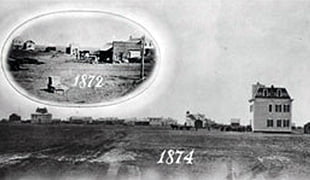Arboretum History
Hastings College was founded May 18, 1882, on 10 acres of treeless prairie on the east side of Hastings. This was and is one tough place for trees with storm, weather extremes, drought and wind. Ground was broken for McCormick Hall on April 25, 1883, and Frank Weyer declared, “What made it unique among ground breaking celebrations, however, was the tree-planting activity.”
 According to minutes of the Board of Trustees, “The people of the vicinity, including the ladies and the school children, assembled on the college grounds for the purpose of setting out trees.” Elinore Barber, College archivist, wrote that there, “…were several wagons piled with trees.” She recounted that 150 persons planted 226 trees representing 33 varieties on that one day.
According to minutes of the Board of Trustees, “The people of the vicinity, including the ladies and the school children, assembled on the college grounds for the purpose of setting out trees.” Elinore Barber, College archivist, wrote that there, “…were several wagons piled with trees.” She recounted that 150 persons planted 226 trees representing 33 varieties on that one day.
The Hastings Weekly Nebraskan (July 19, 1883) reported that several thousand trees were planted that spring. Many of these trees were planted in areas adjoining the campus, such as the Heartwell Park tract on the north and University Avenue to the west. Many of these early trees were given by the Honorable R.W. Furnas, former governor of Nebraska and a Presbyterian elder, from his nursery in Brownville.
The Hastings College arboretum with more than 1,000 trees and several gardens is testimony to the tradition of tree planting and care nurtured by countless dedicated professionals and volunteers from 1883 to the present.
1900-1970s
Records are sketchy at best regarding the people who nurtured the Hastings College arboretum, but a few examples can be listed:
- Hal Lainson remembers that Circle Four of the Presbyterian Church operated a snack shop in the 1920’s and ‘30s near where the Wilson Center stands today and the profits were used to purchase trees for the campus.
- Gretchen Lainson organized a tree planting project in memory of Ralph Adams, Jr., a 1946 class member, who died in France. The bronze plaque is located on a brick pillar of the breezeway between Hurley-McDonald and Perkins Library.
- Russell Davidson, trained in landscape architecture, recommended plantings and design for the campus as early as the late 1940s and in 1968 he was hired to work as groundskeeper where is served until his retirement in 1980.
- The Knappenberger Garden was established in the mid 1970’s in memory of Dr. Jack R. Knappenberger by his family and friends. Knappenberger was a member of the Hastings Board of Trustees from 1968 to 1973.
1980-2005
A Hastings Business Improvement District proposal was selected for participation in the Center for Landscape Stewardship program of the Nebraska Statewide Arboretum. Through this program the Peter Kiewit Foundation provided funds to purchase trees and shrubs for the Gray Center. Matching funds were given by the Hastings College Foundation, Hastings Rotary Club, Spotts Trust, Dutton-Lainson Company, and Earl May Nurseries of Iowa.
The Japanese Friendship Garden was installed in the courtyard on the east side of Hazelrigg Student Union in 1966. The Hastings/Arapahoe/Ozu, Japan International Exchange Program sponsored the project.
The arboretum officially became a part of the Nebraska Statewide Arboretum in 1997 under the leadership of Lyle Fleharty, Director of Physical Plant Services. Accomplishments include:
- Development of a planning process (Master Plan for the Hastings College Arboretum and Botanical Garden),
- The production of a mission statement with goals and objectives,
- Designation of a plan for development of Heartwell Creek on the north campus as an outdoor classroom,
- The signage of several dozen trees,
- The completion of a tree survey in 2000 and the preparation of a notebook listing information on all trees on campus.
2005-Present
- Labyrinth: Built by Hastings College ministry students in 2005, the labyrinth is located near the Circle Drive flagpole. The Labyrinth was rebuilt in 2023 as part of a student service project.
- New Signposts: In the fall of 2006, 150 trees were selected to be marked by 4” x 6” posts and plaques. Eagle Scout candidate Thomas Freetly organized scouts of Troop 200 to install posts and affix name plates.
- Arboretum Website: Hastings College designed and developed an arboretum website.
- Updating Campus Tree Census Notebook: This meets a requirement of the NSA.
- New Arboretum Sign: A new arboretum sign was installed in 2009 at the entrance to Circle Drive.
- Tribute Trees: A tribute tree program was developed by the College Foundation in 2009. Tribute trees are a perfect way to honor or remember a loved one at Hastings College.
- Water Feature: The water cascades over huge boulders and under footbridges into reflecting pools reminding us of the Rocky Mountain high country located between the French Chapel and the Morrison-Reeves Science Center.
- Rain Garden: The rain garden on the west side LEED certified Morrison-Reeves Science Center helps protect water quality by capturing much of the rainwater from the roof and grounds and filtering out 80-90% of potentially harmful pollutants.
- New Campus Tree Nursery: The HC Tree nursery is located just northeast of the Physical Fitness Facility. Over 150 tiny trees were donated or purchased at very low cost and planted by members of the Student Education Association and Student Environmental Action Committee.
- 1883 Tree Planting Reenactment: A reenactment of the original 1883 community tree planting took place on campus April 24, 2010.Trees and rose bushes were planted near the Morrison-Reeves Science Center.
- The Daughters of the American Revolution: A hackberry and elm were planted in 1934 near the Bible House to honor Jennie Hart Fuller and Harriet Kikoff Pratt, charter members of DAR. The marker for Fuller was moved to a prominent location south of Daugherty Center and rededicated in a public ceremony on October 26, 2012.
- April 27, 2013, Arbor Day Planting: Hastings College students, members of either Student Environmental Action Coalition or the Environmental Ethics class, participated in significant tree planting projects. Trees were planted in memory of Dee Yost and Tamara Babcock and three trees from the Hastings College nursery were planted on the west side of the Fleharty Educational Center. Students also “planted forward” 48 bare root trees in the nursery that will be available for future campus landscaping projects.
Tomorrow: Remembering the Mission
These recent improvements to the Hastings College Arboretum will further encourage its use as an important educational resource for several Hastings College departments, Hastings Central Community College, area K-12 students and the community in general. The goals listed below will guide our work:
- Maintain the arboretum so that it continues to be a source of beauty and learning for future generations.
- Work with City of Hastings as it energizes its tree planting program and develops the Highland Park Arboretum.
- Develop management programs for dealing with the threat to ash trees from emerald ash borer.
- Continue to involve volunteer groups such as Student Education Association, Student Environmental Action Committee, service clubs, master gardeners, scout groups, alumni, and emeriti faculty.
- Continue to encourage the use of the arboretum as a resource for students from Hastings College, CCC and area K-12 schools. Provide tour leaders for these groups.
- Encourage the use of the arboretum as a place for spiritual renewal and reflection.
- Continue to develop the campus tree nursery in order to promote increased species diversity, replacement stock and new plantings.
If you have photos, stories and any information regarding the story of Hastings College trees, please contact Will Locke at Hastings College. For sponsorship information or to purchase a legacy tree, view our Arboretum page.

